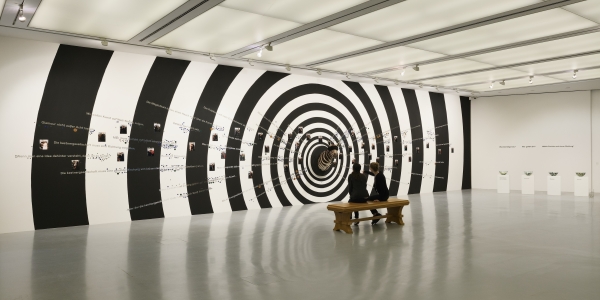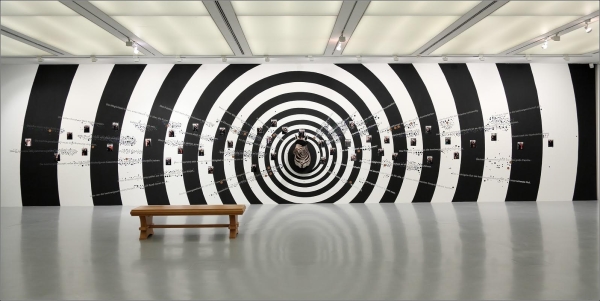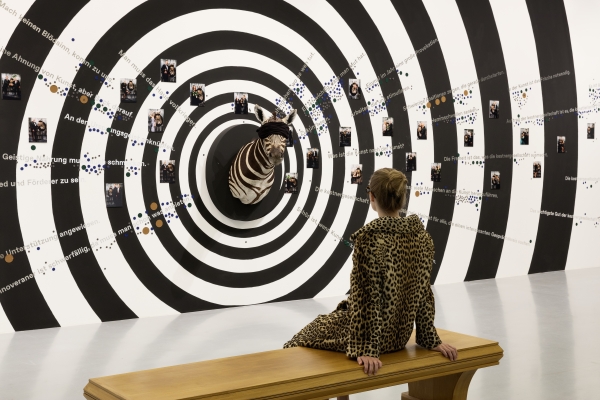It’s Not Just a Matter of Black or White
In: “Stellung Nehmen”
28 May – 21 August 2016
kestnergesellschaft, Hannover, Germany
“It’s Not Just a Matter of Black or White,” 2016
Wall painting, installation, mixed media
“My own Private Vertigo,” 2016
Performance, wooden bench, leopard coat
"It’s Not Just a Matter of Black or White," developed by Christian Philipp Müller for the exhibition "Stellung Nehmen," unfolds within the context of the exhibition as well as in relation to current sociopolitical issues. Müller interviewed numerous personalities from the world of the kestnergesellschaft about their reasons for getting involved, their objectives, and their expectations. Ideas taken from these talks were placed on a large spiral area painted in black and white, which culminated with a hunting trophy. Müller equipped a stuffed zebra bust, originating from the home of one of the respondents, with a blindfold to charge it into a veritable figure of justice.
As with Christian Philipp Müller’s many other works, this installation is the result of a long period of research. An exhibition with an educational as well as social impetus, "Alte Möbel, Neue Kunst” (Old Furniture, New Art, 1952), in which the furniture belonging to members of the kestnergesellschaft were exhibited together with recent art works, served as his starting point. After the end of the war, the focus was on an integrated experience of the present and tradition, as well as contemporary art and the bourgeois household. What is important now? The freedom of artistic programming and the independence of the institution are up for grabs. As part of the 100th anniversary and the extraordinary history of the building — which was forced to close during the Nazi era, and held on to its former Jewish director Justus Bier and modern art as long as possible — more than ever before this question must serve as both a warning and a demand.
But what do artistic freedom and independence mean for an institution today? To which network of dependence, requirements, and expectations does the kestnergesellschaft belong at the beginning of the 21st century? Who are the "stakeholders" and what demands are placed on the institution? The kestnergesellschaft’s underlying membership structure equips them with different participants from civil society. Moreover, other circles — not least the audience — correctly raise their claims and demands. Once a day, a woman in a fur coat with an updo appears before the installation. As in Alfred Hitchcock's "Vertigo" she seems hypnotized by the spiral of greed. What beliefs are effective when one is confronted with the real politics of an institution in the 21st century?
Müller has championed an understanding of working as a process, that is, only temporality and the actions that take place therein complete the work. In numerous projects, he has involved plants, which are regarded as a cultural asset with socio-political implications such as biodiversity (“Swiss Chard Ferry,” dOCUMENTA 13, 2012), colonial history (“Die neue Welt,” Melk Abbey, 2006) or emigration (“Observatory,” Art and Exhibition Hall in Bonn, 2015). "It’s Not Just a Matter of Black or White " also serves as a catalyst, in which visitors are invited to contribute their opinion by affixing different adhesive dots to the work. Over the course of the exhibition, the wall work continuously changes. The result is an expansive, cartographic installation, in which the complex of different actors who meet in an institution like the kestnergesellschaft will be visible. Who is subject to which beliefs and values — their own private Vertigo? In a time when the polarizing tendency favors thinking in terms of black and white, Müller makes the grays visible.
Text by Christina Végh
Translation by Cara Jordan




